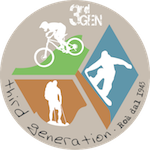When we plan a trip and start reading the itinerary guides we need to know what all those abbreviated syllables mean… Better to be prepared and inquire than to find out on the spot!!!!
These abbreviations are nothing more than the corresponding degree of difficulty of the various scales of ski mountaineering and consequently of splitboarding.
The most used and known scales are 4:
THE INTERNATIONAL SCALE (Blachère)
ALPINISTIC SCALE, used in particular for the ascent
PUNCTUAL EVALUATION ("Traynard" scale)
OPEN EVALUATION (“Volo” or “Toponeige” scale)
Let's get to know them in detail:
The INTERNATIONAL SCALE (Blachère) is still used in almost all the itineraries guides. This very simple system consists of three main abbreviations and one complementary abbreviation. It allows you to evaluate the itinerary as a whole with reference to the skier's technical ability and naturally refers to good snow conditions.
MS: Medium Skier. it is able to turn on average slopes of less than 25°. Fear steep slopes and narrow passages.
BS: Good Skier. Technical mastery on steep terrain up to 40° and in narrow couloirs.
OS: Excellent Skier. Excellent command of skiing even on very steep terrain, with exposed sections and obligatory passages.
If the itinerary also includes difficulties of a mountaineering nature for which the skier must be familiar with the use of a rope, ice ax or crampons (e.g. crossing glaciers with crevasses, climbing sections, steep slopes, length of the itinerary, frames, etc.), the Alpinist characteristic is added and this is what you get.
MSA: Medium Skier Alpinist.
BSA: Good Skier Alpinist.
OSA: Excellent Skier Alpinist.
The ALPINISTIC SCALE is used almost exclusively to attribute a difficulty to the climb.
F: easy, gentle slopes or snowy road with little or no U-turns
PD: not very difficult and slightly steeper than F, some narrow passages, inversions are always easy.
AD: quite difficult the slopes are from 20° to 30°, they can be narrow and forced, some inversions can be difficult.
D: difficult, serious slopes from 30° to 40°, sustained and continuous, very delicate inversions, it may be necessary to take off the skis
TD: very difficult, continuous 40°/45° slopes, progression usually takes place with skis on the rucksack and crampons on the feet. A + is added if the difficulty lies between one category and another
The PUNCTUAL EVALUATION ("Traynard" scale) complementary to the global evaluation, examines the difficulty of the most delicate passage of the descent on skis. It is mainly related to the slope, but also takes into account the exposure.
Its various grades are:
S1: easy itinerary that does not require any particular technique to move safely, such as a forest road.
S2: Quite high slopes, even a little steep (25°) or hilly itineraries.
S3: Inclination of the slopes up to 35° (the steepest black slopes of the ski resorts, with hard snow). The ascent on any type of snow is practiced without technical difficulties.
S4: Inclination of slopes up to 45° if the exposure is not too strong; starting from 30° and up to 40° if the exposure is strong or the passage is narrow. A very good skiing technique is indispensable here.
S5: Inclinations from 45 to 50° or even greater if the exposure is weak. Starting from 40° if the exposure is strong. In addition to a perfect technique, a psychological balance also becomes important.
S6: Beyond 50° if the exposure is strong, which is the case in most cases. Otherwise starting from 55° for short passages with little exposure.
S7: passes at 60° or more, or jumping obstacles in very steep or exposed terrain.
The OPEN EVALUATION (“Volo” or “Toponeige” scale), invented by Volodia Shashahani, is mainly based on three parameters:
1 - The difficulty of the ski part deriving from the inclination of the slope and the length
2 - The exposure of the slope
3 - The difficulty of the climb (see difficulty Alpinistic scale)
The assessment of the difficulty of the descent is divided into 5 levels. The first three levels are in turn divided into 3 sub-levels and express the difficulties of classic ski mountaineering. The fourth level identifies classic steep skiing, and is also divided into three sub-levels. The fifth level represents extreme skiing and its sub-levels have no limits.
The levels of technical evaluation are:
Level 1 (1.1, 1.2, 1.3): very simple and wide slopes with transitions never exceeding 30°. Total elevation gain less than 800m and zero exposure
Level 2 (2.1, 2.2, 2.3): slopes without technical difficulties and no passage reaches 35°. Difference in height and exposure can become significant.
Level 3 (3.1, 3.2, 3.3): there are technical passages and slopes up to 35°, even very long ones, with any short stretches at 40-45°
Level 4 (4.1, 4.2, 4.3): it is gully skiing or classic steep skiing. Very long 40° slopes with short passages up to 50°
Level 5 (5.1, 5.2, 5.3, 5.4, ....): very long slopes starting from 45° with passages at at least 50°
The slope exposure evaluation scale is divided into 4 levels:
E1: no major obstacles, uniform and well connected slope
E2: the descent line has a small rock bar which, if jumped, does not involve the risk of a violent collision
E3: certain risk of jumping over a rock bar or banging violently against rock or ice. Never fall!
E4: presence of very high or multiple rock or ice bars, high and open terminals. Never fall!




